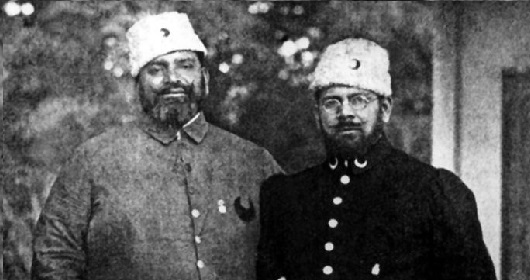
Key Question 7: How successful was the Khilafat Movement in advancing the cause of Pakistan Movement?
Khilafat Movement
Background:
• The Lucknow Pact made Hindus and Muslims of India work together in matters of the constitutional and political issues.
• However, the Hindu-Muslim unity came to its conclusion during the Khilafat Movement.
• At the start of WWI, the Ottoman Empire of Turkey held the seat of Khilafat.
• The Turks stand beside Austria and Germany to fight against Russia, Britain, and France.
• The British wanted Indian Muslims to join in the fight alongside them and promised them that they will protect the Khalifa and the Ottoman Empire.
• As a result, thousands of Muslims joined the army.
• But the Turkish side lost the war and Muslims became concerned about the Khalifa and the Ottoman Empire.
Reasons for the Rise of the Khilafat Movement:
• After the Turkish side lost, Britain captured the Ottoman Empire including Madinah and Makkah. To protect these places the movement was launched.
• The Khalifa (Caliph) of Turkey was dethroned.
• The British wanted to end the Ottoman Empire and force Turkey to be treated like a normal country.
• The British forgot their promise to treat Turkey better.
• The Muslims of India were grieve stricken because Turkey was the last great power left to them.
• They believed, if Britain destroyed Turkey then Muslims will become like Jews, people without a country of their own.
The Khilafat Committee and its Objectives:
• In 1919, the Khilafat Committee was established to launch the Khilafat Movement.
• Maulana Shaukat Ali was decided as the General Secretary of the Khilafat Movement.
• The National Congress also gave their support to the movement.
Objectives:
• Following were the main objectives of the movement:
- To protect the holy places of Muslims.
- To defend the Khalifa.
- To protect the Ottoman Empire.
1st Khilafat Conference:
• The first Khilafat Conference was held on November 1919 at Delhi.
• Gandhi also attended the Khilafat Conference.
• A resolution was passed that demanded Muslims of India to adopt the non-cooperation policy to fulfill their religious duty.
2nd Khilafat Conference:
• The second Khilafat Conference was held in December 1919 at Amritsar.
• National Congress and the Muslim League also attended the second Conference.
• It was decided that all three of them must work together to oppose the plans of the British to end the Ottoman Empire.
Khilafat Delegation:
• In 1919, under the leadership of Muhammad Ali Johar, the Khilafat Delegation left for England to discuss their concerns with Lloyd George, the Prime Minister.
• However, the Lloyd George refused any arguments regarding the Khalifa and Ottoman Empire and the Movement failed without achieving its goal.
Failure of the Khilafat Movement:
• The demands and arguments made by the Khilafat Delegation were rejected.
• Under British policy of repression, around 30,000 supporters were arrested.
• The Ali brother, Maulana Shaukat Ali and Maulana Muhammad Ali were arrested.
• After the incident of Chauri Chaura, Gandhi also withdrew his support from the Khilafat Movement.
• In 1924, under the leadership of Mustafa Kamal Turks announced the end of Khilafat, it came as a blow to the Indian Muslims.
Hijrat Movement
Background:
• The Hijrat Movement was launched by the influence of the Khilafat Movement.
• In 1920, suggestions were made by Jamiyat-al-Ulema-i-Hind for Hijrat Movement.
• The Ulema explained that when the land became unsafe Muslims have two options, either to stand up and do Jihad or to migrate to a safe place.
• This Fatwa was singed by around 925 renowned Muslims.
• In Delhi, after the Fatwa, a central office was established and Nazims were appointed to motivate Muslims for migration.
Failures of the Hijrat Movement:
• After the launch of Hijrat Movement, hundreds of Muslim families in Sindh and NWFP sold their properties and home to migrate to Afghanistan.
• However, Afghanistan being a poor country was unable to accept this large crowd of migrants.
• In August 1920 alone, around 1800 people migrated to Afghanistan.
• At the start, Afghans welcomed the Indian Muslims, but they had to close their frontiers because of the shortage of food for refugees.
• The refugees in Afghan face miserable conditions and many hardships, some even came back to their homeland.
• The Khilafat Movement also failed, and the Muslims were India have once again faced criticism from Hindus.
Gandhi & the Non-Cooperation Movement
Background:
• Gandhi was a man, who did not believe in violence.
• He launched the non-cooperation movement to protest the British.
• However, his movement lost its momentum and was leading towards violence.
Chauri-Chaura Incident:
• In February 1922, the riot became intense between the protestors of Non-Cooperation Movement and police at Chauri-Chaura.
• The hostile protestors set the police station on fire that burnt 22 policemen alive.
• The Chauri-Chaura incident made Gandhi very upset and he immediately called off the movement.
• The sudden end of the non-cooperation movement also harmed the Khilafat Movement.
